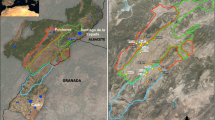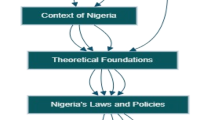Abstract
This paper shows that the Huaorani Indians of the Ecuadorian Amazon possess a long-standing common property management regime fostered by secure ownership status of the land, the small size and kinship ties of residence groups, the existence of mutual trust and reciprocity, and culturally sanctioned rules of behavior. This regime, however, was focused on maintaining harmonious relationships between residents of the nanicabo and not on resource conservation (although it may have fostered epiphenomenal conservation). It cannot be presumed that communal management of resources invariably leads to conservation; other factors need to be present, such as a perception of resource scarcity. The common property regime was designed for a situation of plentiful resources, low population density, clear membership, and behaviors held in check by respect for kin and the desire for good standing. It was a sufficient and simple system for delimiting common property resources from private property, based on implicit social boundaries and cultural understandings. Now, confronted by powerful external forces, population growth, and intermarriage with non-Huaorani, the system is faltering. Conservationist practices, however, can be encouraged by adapting the earlier system to reflect current conditions.
Similar content being viewed by others
References
Acheson, J. M. (1987). The lobster fiefs revisited: Economic and ecological effects of territoriality in Maine lobster fishing. In McCay, B. J., and Acheson, J. M. (eds.), The Question of the Commons: The Culture and Ecology of Communal Resources, University of Arizona Press, Tucson, pp. 37–65.
Alcorn, J. (1989). Process as resource: The traditional agricultural ideology of Bora and Huastec resource management and its implications for research. In Posey, D. A., and Balée, W. (eds.), Resource Management in Amazonia: Indigenous and Folk Strategies, New York Botanical Gardens, New York, pp. 63–77.
Alcorn, J. (1995). Comments in response to Alvard's “Intraspecific prey choice by Amazonian hunters.” Current Anthropology 36: 789–818.
Alvard, M. (1993). Testing the “ecologically noble savage” hypothesis. Human Ecology 21: 355–387.
Alvard, M. (1994). Conservation by native peoples: Prey choice in a depleted habitat. Human Nature 5: 127–154.
Alvard, M. (1995). Intraspecific prey choice by Amazonian hunters. Current Anthropology 36: 789–818.
Bauer, D. (1987). The dynamics of communal and hereditary land tenure among the Tigray of Ethiopia. In McCay, B. J., and Acheson, J. M. (eds.), The Question of the Commons: The Culture and Ecology of Communal Resources, University of Arizona Press, Tucson, pp. 217–230.
Berkes, F. (1987). Common-property resource management and Cree Indian fisheries in Subartic Canada. In McCay, B. J., and Acheson, J. M. (eds.), The Question of the Commons: The Culture and Ecology of Communal Resources, University of Arizona Press, Tucson, pp. 66–91. 446 Lu
Blaikie, P., Harriss, J., and Pain, A. (1992). The management and use of common-property resources in Tamil Nadu, India. In Bromley, D. W. (ed.), Making the Commons Work: Theory, Practice, and Policy, Institute for Contemporary Studies, San Francisco, pp. 247–264.
Bromley, D. W., and Cernea, M. M. (1989). The management of common property natural resources: Some conceptual and operational fallacies, World Bank Discussion Papers No. 57, The World Bank, Washington, DC.
Campbell, B. M. S., and Godoy, R. A. (1986). Commonfield agriculture: The Andes and medieval England compared, Development Discussion Paper No. 220, Harvard Institute for International Development, Harvard University, Cambridge.
Clad, J. C. (1988). Conservation and indigenous people: A study of convergent interests. In Bodley, J. H. (ed.), Tribal Peoples and Development Issues: A Global Overview, Mayfield, Mountain View, pp. 320–333.
Gibbs, C. J. N., and Bromley, D. W. (1989). Institutional arrangements for management of rural resources: Common property regimes. In Fikret Berkes, F. (ed.), Common Property Resources: Ecology and Community-Based Sustainable Development, Belhaven, London, pp. 22–32.
Gilles, J. L., Hammoudi, A., and Hahdi, M. (1992). Oukaimedene, Morocco: A high mountain Agdal. In Bromley, D.W. (ed.), Making the CommonsWork: Theory, Practice, and Policy, Institute for Contemporary Studies, San Francisco, pp. 229–246.
Goodland, R., Ledec, G., and Webb, M. (1989). Meeting environmental concerns caused by common property mismanagement in economic development projects. In Berkes, F. (ed.), Common Property Resources: Ecology and Community-Based Sustainable Development, Belhaven, London, pp. 148–163.
Hardin, G. (1968). The tragedy of the commons. Science 162: 1243–1248.
Hicks, J. F. (1990). Ecuador's Amazon region: Development issues and options, World Bank Discussion Paper No. 75, The World Bank, Washington, DC.
Hill, K. (1996). The Mbaracayú Reserve and the Aché of Paraguay. In Redford, K., and Mansour, J. A. (eds.), Traditional Peoples and Biodiversity Conservation in Large Tropical Landscapes, America Verde Publications, The Nature Conservancy, Latin America and Caribbean Division, Arlington, pp. 158–195.
Jodha, N. S. (1992). Common property resources: A missing dimension of development strategies, World Bank Discussion Papers No. 169, The World Bank, Washington, DC.
Kimerling, J. (1991). Amazon Crude, Natural Resources Defense Council, Washington, DC.
Larrick, J. W., Yost, J. A., Kaplan, J., King, G., and Mayhall, J. (1979). Patterns of health and disease among theWaorani Indians of Eastern Ecuador. Medical Anthropology 3(2): 147–189.
Lu, F. E. (1999). Changes in Subsistence Patterns and Resource Use of the Huaorani Indians in the Ecuadorian Amazon, Doctoral Dissertation, Curriculum in Ecology, University of North Carolina at Chapel Hill.
May, P.H. (1992).Commonproperty resources in the neotropics:Theory, management progress, and an action agenda. In Redford, K. H., and Padoch, C. (eds.), Conservation of Neotropical Forests: Working From Traditional Resource Use, Columbia University Press, New York, pp. 359–378.
McCloskey, D. M. (1976). Open fields as behavior toward risk. Research in Economic History 1: 144–170.
McKean, M. A. (1992). Management of traditional common lands (Iriaichi) in Japan. In Bromley, D. W. (ed.), Making the Commons Work: Theory, Practice, and Policy, Institute for Contemporary Studies, San Francisco, pp. 63–98.
McKean, M. A. (1996). Common property: What is it, what is it good for, and what makes it work? Phase II Working Papers, Forests, Trees, and People Programme, Food and Agriculture Organization of the United Nations.
Netting, R. M. (1981). Balancing on an Alp: Ecological Change and Continuity in a Swiss Mountain Community, Cambridge University Press, New York.
Ostrom, E. (1992). The rudiments of a theory of the origins, survival, and performance of common-property institutions. In Bromley, D.W. (ed.), Making the CommonsWork: Theory, Practice, and Policy, Institute for Contemporary Studies, San Francisco, pp. 293–318.
Ostrom, E. (2001). Reformulating the commons. In Burger, J., Ostrom, E., Norgaard, R. B., Policansky, D., and Goldstein, B. D. (eds.), Protecting the Commons: A Framework for Resource Management in the Americas, Island, Washington, DC, pp. 17–41.
Redford, K. H. (1990). The ecologically noble savage. Orion Summer 1990: 25–29.
Rival, L. M. (1992). Social Transformations and the Impact of Formal Schooling on the Huaorani of Amazonian Ecuador, Doctoral Dissertation, London School of Economics, University of London.
Robarchek, C., and Robarchek, C. (1998).Waorani: The Contexts ofViolence andWar, Harcourt Brace, Fort Worth.
Ruttan, L. M. (1998). Closing the commons: Cooperation for gain or restraint? Human Ecology 26: 43–66.
Smith, R. C. (1996). Biodiversity won't feed our children: Biodiversity conservation and economic development in indigenous Amazonia. In Redford, K., and Mansour, J. A. (eds.), Traditional Peoples and Biodiversity Conservation in Large Tropical Landscapes, America Verde Publications, The Nature Conservancy, Latin America and Caribbean Division, Arlington, pp. 197–218.
Stevenson, G. G. (1991). Common Property Economics: A General Theory and Land Use Applications, Cambridge University Press, Cambridge.
Vondal, P. J. (1987). The common swamplands of Southeastern Borneo: Multiple use, management, and conflict. In McCay, B. J., and Acheson, J. M. (eds.), The Question of the Commons: The Culture and Ecology of Communal Resources, University of Arizona Press, Tucson, pp. 231–249.
Wade, R. (1992). Common-property resource management in South Indian villages. In Bromley, D. W. (ed.), Making the Commons Work: Theory, Practice, and Policy, Institute for Contemporary Studies, San Francisco, pp. 207–228.
Whitten, N. E. (1978). Amazonian Ecuador: An ethnic interface in ecological, social, and ideological perspectives, IWIGIA Document No. 34, International Work Group for Indigenous Affairs, Copénhagen.
Yost, J. A. (1981). Twenty years of contact: The mechanisms of change inWao (“Auca”) culture. In Whitten, N. E., Jr. (ed.), Cultural Transformations and Ethnicity in Modern Ecuador, University of Illinois Préss, Urbana, pp. 677–704.
Yost, J. A. (1991). People of the forest: TheWaorani. In Acosta-Solis, M. (ed.), Ecuador in the Shadow of Volcanoes, Ediciones Libri Mundi, Quito, pp. 95–115.
Author information
Authors and Affiliations
Rights and permissions
About this article
Cite this article
Lu, F.E. The Common Property Regime of the Huaorani Indians of Ecuador: Implications and Challenges to Conservation. Human Ecology 29, 425–447 (2001). https://doi.org/10.1023/A:1013193821187
Issue Date:
DOI: https://doi.org/10.1023/A:1013193821187




